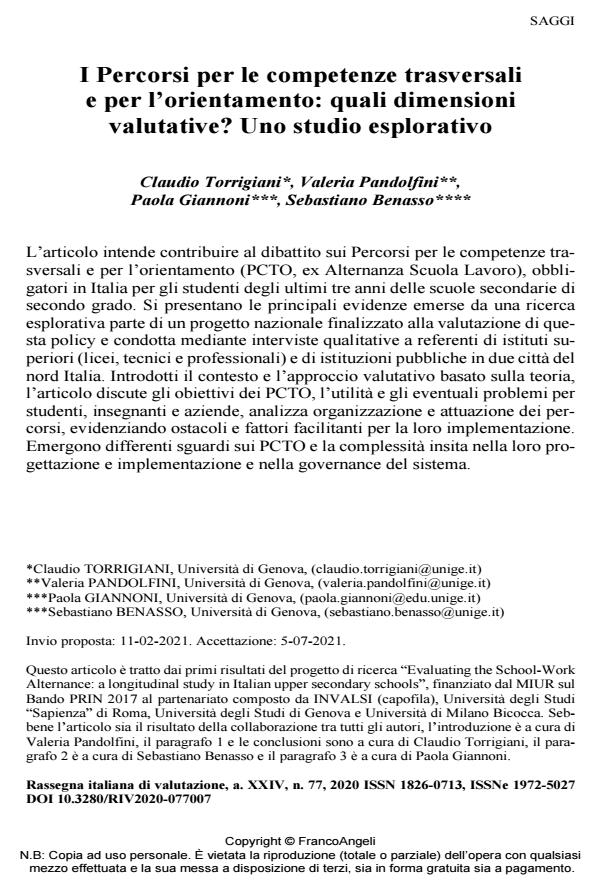I Percorsi per le competenze trasversali e per l’orientamento: quali dimensioni valutative? Uno studio esplorativo
Journal title RIV Rassegna Italiana di Valutazione
Author/s Claudio Torrigiani, Valeria Pandolfini, Paola Giannoni, Sebastiano Benasso
Publishing Year 2022 Issue 2020/77 Language Italian
Pages 19 P. 115-133 File size 259 KB
DOI 10.3280/RIV2020-077007
DOI is like a bar code for intellectual property: to have more infomation
click here
Below, you can see the article first page
If you want to buy this article in PDF format, you can do it, following the instructions to buy download credits

FrancoAngeli is member of Publishers International Linking Association, Inc (PILA), a not-for-profit association which run the CrossRef service enabling links to and from online scholarly content.
- Arnett J. J. (2004). Emerging adulthood: The winding road from the late teens through the twenties. New York: Oxford University Press.
- Ballarino G, Checchi D. (a cura di) (2006). Sistema scolastico e disuguaglianza sociale, Il Mulino, Bologna.
- Barone C., Triventi M. (in press). Is vocational education a safety net? The occupational attainment of upper secondary graduates from vocational and academic tracks in Italy. Quaderni di Sociologia, 2021.
- Callaghan G. (2008). Evaluation and Negotiated Order, Evaluation, vol. 14, n. 4: 399-412.
- Caroleo F. E., Demidova O., Marelli E., Signorelli. M. (2017). Young People and the Labour Market. A Comparative Perspective. London: Routledge.
- Ciarini A., Giancola O. (2016). Le politiche educative in Italia: tra spinte esogene, cambiamenti endogeni e diseguaglianze persistenti, Rivista delle politiche sociali, 2: 61-80.
- Costa V. (2016). Circolo ermeneutico, ibridazione scuola-lavoro e lifelong learning. Un approccio fenomenologico. Formazione, Persona e Società, 6: 16–25.
- Crocetti E., Moscatelli S., Van Der Graaff J., Rubini M., Meeus W., Branje S. (2016). The interplay of self-certainty and prosocial development in the transition from late adolescence to emerging adulthood. European Journal of Personality, 30: 594–607.
- Erikson E. H. (1968). Identity, youth and crisis. New York: Norton.
- European Commission (2018). Council Recommendation on key competences for lifelong learning. Official Journal of the European Union. (2018/C – 189/01)
- Hadjivassiliou K., Tassinari A., Eichhorst W., Wozny F. (2016). Assessing the Performance of School to-Work Transition Regimes in the EU. IZA Discussion Paper 10301. Bonn: IZA.
- Ministero dell’Istruzione, dell’Università e della Ricerca, 2019, Percorsi per le competenze trasversali e per l’orientamento. Linee guida. -- https://www.miur.gov.it/documents/20182/1306025/Linee+guida+PCTO+con+allegati.pdf/ Consultato il 06/02/2021
- Pastore F. (2015). The Youth Experience Gap. Explaining National Differences in the School-to-Work Transition. Cham: Springer.
- Pawson R. (2006). Evidence-based Policy. A realist Perspective, Sage, London.
- Pawson R. (2013). The Science of Evaluation: A Realist Manifesto, Sage, London.
- Pawson R., Tilley N. (1997). Realistic Evaluation, Sage, London.
- Raffe, D. (2008). The concept of transition system. Journal of Education and Work, 21: 277–296.
- Pinna G., Pitzalis M. (2020). Tra scuola e lavoro. L’implementazione dell’Alternanza scuola lavoro tra siseguaglianze scolastiche e sociali. Scuola Democratica, 1: 17-35.
- Raffe D. (2014). Explaining National Differences in Education-Work Transitions: Twenty Years of Research on Transition Systems. European Societies 16 (2): 175–193.
- Rossi P.H., Lipsey M.W., Freeman H.E. (2004). Evaluation. A Systematic Approach, Sage, London.
- Scandurra R., Cefalo R., Kazepov Y. (2020). School to work outcomes during the Great Recession, is the regional scale relevant for young people’s life chances? Journal of Youth Studies.
- Schoon I., Silbereisen R. K. (2009). Transitions from School to Work: Globalisation, Individualisation, and Patterns of Diversity. Cambridge: Cambridge University Press.
- Stame N. (2001). “Tre approcci principali alla valutazione: distinguere e combinare”. In Mauro Palumbo, Il processo di valutazione. Decidere, programmare, valutare, FrancoAngeli, Milano, pp. 21-46 e pp. 94-96.
- Tomei G. (2016). Valutare gli outcome dei programmi complessi, FrancoAngeli, Milano
- Weiss C.H. (2000). “Theory-based Evaluation: Theories of Change for Poverty Reduction Programs”. In O. Feinstein, R. Picciotto (a cura di), Evaluation and Poverty Reduction. Word Bank, Washington D.C.
- Didattica speciale e sviluppo delle competenze lavorative e di vita indipendente Angelo Lascioli, Ivan Traina, in EDUCATION SCIENCES AND SOCIETY 2/2022 pp.144
DOI: 10.3280/ess2-2022oa14535
Claudio Torrigiani, Valeria Pandolfini, Paola Giannoni, Sebastiano Benasso, I Percorsi per le competenze trasversali e per l’orientamento: quali dimensioni valutative? Uno studio esplorativo in "RIV Rassegna Italiana di Valutazione" 77/2020, pp 115-133, DOI: 10.3280/RIV2020-077007